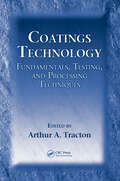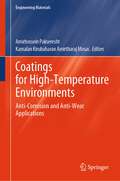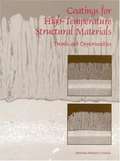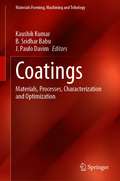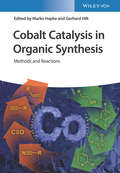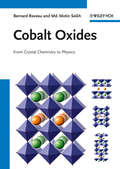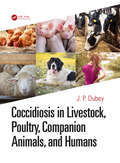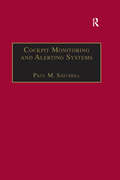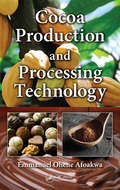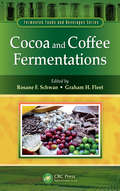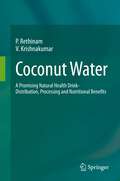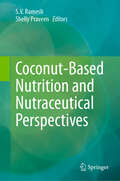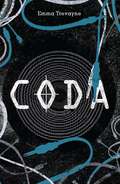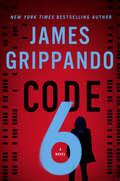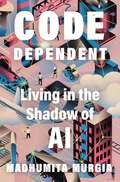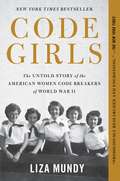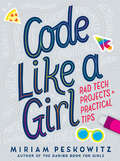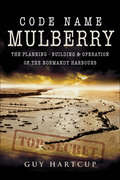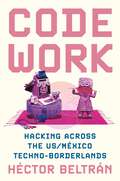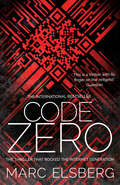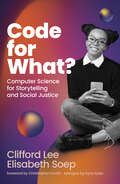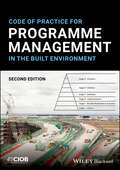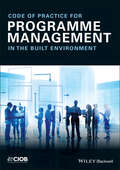- Table View
- List View
Coatings Technology: Fundamentals, Testing, and Processing Techniques
by Arthur A. TractonDrawn from the third edition of The Coatings Technology Handbook, this book focuses entirely on testing, experimental design, and strategies for selecting processing techniques in the coatings, adhesives, paints, and inks industries. Coatings Technology: Fundamentals, Testing, and Processing Techniques contains the latest coating and processing met
Coatings for High-Temperature Environments: Anti-Corrosion and Anti-Wear Applications (Engineering Materials)
by Amirhossein Pakseresht Kamalan Kirubaharan Amirtharaj MosasThis book addresses the recent trends in high-temperature coatings that are used to provide oxidation and wear resistance to metallic/ceramic components in extreme environments. Ceramics, intermetallics, organosilicon polymers, cermets, and other materials with great thermal stability have long been recognized for these applications. This book introduces the state of the art in coating materials and processes for high-temperature environments and identifies areas for improvement in materials selection, performance upgrades, design considerations, and manufacturing methods. The book covers a variety of high-temperature coatings prepared through various synthesis processes such as thermal spraying, physical vapor deposition, electrodeposition, and sol–gel methods. It covers corrosion/oxidation, phase stability, and thermal and mechanical behavior of high-temperature coating materials having greater thermal stability.With contributions from international researchers active in the field, this edited book features the most recent and up-to-date literature references for a broad readership consisting of academic and industrial professionals. It is suitable for graduate students as well as scientists and engineers working in the area of anti-corrosion and anti-wear resistant high-temperature coatings for industrial applications.
Coatings for High-Temperature Structural Materials: Trends and Opportunities
by Committee of Coatings for High-Temperature Structural MaterialsThis book assesses the state of the art of coatings materials and processes for gas-turbine blades and vanes, determines potential applications of coatings in high-temperature environments, identifies needs for improved coatings in terms of performance enhancements, design considerations, and fabrication processes, assesses durability of advanced coating systems in expected service environments, and discusses the required inspection, repair, and maintenance methods. The promising areas for research and development of materials and processes for improved coating systems and the approaches to increased coating standardization are identified, with an emphasis on materials and processes with the potential for improved performance, quality, reproducibility, or manufacturing cost reduction.
Coatings: Materials, Processes, Characterization and Optimization (Materials Forming, Machining and Tribology)
by J. Paulo Davim Kaushik Kumar B. Sridhar BabuThis book presents recent developments in the coating processes, sub processes and emphasizes on processes with the potential to improve performance quality and reproducibility. The book demonstrates how application methods, environmental factors, and chemical interactions affect each surface coating's performance. In addition, it provides analysis of latest polymers, carbon resins, high-temperature materials used for coatings and describes the development, chemical and physical properties, synthesis, polymerization, commercial uses and characteristics for each raw material and coating. Characterization techniques to solve the coating problems are also presented, as well as optimization studies to identify the critical coating parameters to ensure a robust process.
Cobalt Catalysis in Organic Synthesis: Methods and Reactions
by Marko HapkeProvides a much-needed account of the formidable "cobalt rush" in organic synthesis and catalysis Over the past few decades, cobalt has turned into one of the most promising metals for use in catalytic reactions, with important applications in the efficient and selective synthesis of natural products, pharmaceuticals, and new materials. Cobalt Catalysis in Organic Synthesis: Methods and Reactions provides a unique overview of cobalt-catalysed and -mediated reactions applied in modern organic synthesis. It covers a broad range of homogeneous reactions, like cobalt-catalysed hydrogenation, hydrofunctionalization, cycloaddition reactions, C-H functionalization, as well as radical and biomimetic reactions. First comprehensive book on this rapidly evolving research area Covers a broad range of homogeneous reactions, such as C-H activation, cross-coupling, synthesis of heterocyclic compounds (Pauson-Khand), and more Chapters on low-valent cobalt complexes as catalysts in coupling reactions, and enantioselective cobalt-catalyzed transformations are also included Can be used as a supplementary reader in courses of advanced organic synthesis and organometallic chemistry Cobalt Catalysis in Organic Synthesis is an ideal book for graduates and researchers in academia and industry working in the field of synthetic organic chemistry, catalysis, organometallic chemistry, and natural product synthesis.
Cobalt Oxides
by Motin Seikh Bernard RaveauUnparalleled in the breadth and depth of its coverage of all important aspects, this book systematically treats the electronic and magnetic properties of stoichiometric and non-stoichiometric cobaltites in both ordered and disordered phases. Authored by a pioneer and a rising star in the field, the monograph summarizes, organizes and streamlines the otherwise difficult-to-obtain information on this topic. An introductory chapter sets forth the crystal chemistry of cobalt oxides to lay the groundwork for an understanding of the complex phenomena observed in this materials class. Special emphasis is placed on a comprehensive discussion of cobaltite physical properties in different structural families.Providing a thorough introduction to cobalt oxides from a chemical and physical viewpoint as a basis for understanding their intricacies, this is a must-have for both experienced researchers as well as entrants to the field.
Coccidiosis in Livestock, Poultry, Companion Animals, and Humans
by J. P. DubeyCoccidiosis is one of the most important diseases of livestock, particularly poultry, with billions of dollars spent on prevention worldwide. The disease is so important and pervasive that until recently, all poultry feed was medicated with coccidiostats, mainly antibiotics. With the rapid development of drug resistance, the search is on for alternative methods of control of coccidiosis in poultry. With chapters authored by internationally renowned scientists, this book covers coccidiosis in all major livestock species, including cattle, sheep, and goats. Special emphasis is given to poultry coccidiosis given the significant economic impact, and another chapter looks at intestinal coccidiosis in humans, including Cyclospora. Chapters discuss techniques, molecular biology, host-pathogen immunobiology and immunoprophylaxis, genetics and genomics, biology, and chemotherapy. Despite an explosion of research in the last 40 years, there has been no new book published discussing conventional coccidiosis for more than 25 years. This comprehensive review therefore answers an urgent need for a book dealing exclusively with conventional coccidia (Cystoisospora, Cyclospora). It provides concise, authoritative, up-to-date information on coccidiosis, with particular attention given to research in the last 28 years. This book is essential reading for any practitioner or researcher involved in livestock production, including biologists, veterinarians, parasitologists, and researchers from government, academia, and industry.
Cockpit Monitoring and Alerting Systems
by Paul M. SatchellWhile monitoring of computer-controlled systems is widespread, it is critically important in the cockpit of current passenger aircraft. Such monitoring requires special vigilance for those rare untoward events, which may be new to the pilot and which can have devastating consequences. This book uses a multidisciplinary approach to address this problem of sustaining attention while monitoring. It outlines and explains alternative ways of viewing the processes needed to prevent Human Factors accidents; it examines the use and limitations of cockpit resource management programmes in inducing behavioural and attitudinal changes appropriate for highly automated flight decks. The author’s approach deals rigorously with the physiological mechanisms underlying vigilance, arousal and stress, delineating clearly those that are relevant to the monitoring function. The three parts cover: monitoring problems and processes; monitoring measurement and alerting systems; and monitoring management. In the last part the author details management plans and guidance for monitoring assisted systems based on his understanding of the problems of continued human vigilance. Readership: pilots and training pilots; cockpit resource management groups; monitoring management specialists; university aviation departments; road and rail transport groups; those operating nuclear and large process installations.
Cocoa Production and Processing Technology
by Emmanuel Ohene AfoakwaThis book presents detailed explanations of technologies for sustainable production of high-quality and safe cocoa beans for the global confectionary industry. It describes up-to-date technologies and approaches to modern cocoa production practices, global production and consumption trends as well as principles of cocoa processing and chocolate manufacture. It covers the origin, history and taxonomy of cocoa, and examines the fairtrade and organic cocoa industries. The chapters provide in-depth coverage of cocoa cultivation, harvesting and post-harvest treatments, genotypic variations, fermentation techniques, drying, storage and transportation.
Cocoa and Coffee Fermentations (Fermented Foods and Beverages Series)
by Graham H. Fleet Rosane F. SchwanThis is the first book to focus on the scientific principles underlying the fermentation processes of cocoa and coffee beans and their impact on product quality and safety. The text compiles the knowledge from the different disciplines involved in fermentation, including botany, chemistry, microbiology, biochemistry, food science, and sensory science. The chapters discuss the botanics of the beans; fermentation methods; the microbiology of fermentation; the biochemistry and physiology of fermentation; the impacts of fermentation on bean flavor, quality, and safety; chocolate and coffee derived from the beans; and the processing of waste materials.
Coconut Chaos: Pitcairn, Mutiny And A Seduction At Sea
by Diana SouhamiAt dawn on 27 April 1789 Fletcher Christian, master's mate on HMS Bounty, took a coconut to quench his thirst from the supply on the quarterdeck. This seemingly insignificant act resulted in mutiny, chaos and a chain of events that leads right up to the present day. With a story driven by hazardous and extraordinary sea voyages and a cast that includes the Bounty mutineers, an eccentric lesbian aristocrat, Pitcairn Island sex offenders and the narrator's ancient mother, this sparkling and original book weaves together fact and fiction, history and autobiography, humour and danger in inimitable style.
Coconut Water: A Promising Natural Health Drink-Distribution, Processing and Nutritional Benefits
by V. Krishnakumar P. RethinamCoconut water, a naturally-canned tropical beverage, has been gaining popularity in recent years and has drawn the attention world over as a natural and nutritional wellness beverage. The research published thus far on coconut water has mainly focused on its specific uses, biochemical composition and health benefits as well as processing and preservation techniques and has been published mostly in journal articles. Only a few books covering a wide spectrum of coconut water for health and wellness are currently available. This work offers a comprehensive and fully updated overview of coconut water from processing techniques to value addition to safety to nutritional benefits and beyond. Coconut Water: Processing, Distribution & Nutritional Benefits provides in-depth details on all of the major processing techniques required to produce and maintain a quality product free of contamination and adulteration. The book covers the standards of coconut water production and distribution in various countries enabling the processors and exporters to manufacture and export for better revenue realization. The book also provides details of patents related to coconut water granted to researchers. Another important aspect of this work is comprehensive coverage on the various nutritional and health benefits of coconut water consumption as well as on the value addition (traditional and innovative products). In markets across the world, consumers of all ages have been turning to coconut water for its taste and nutritional benefits. This book will provide researchers, processors and exporters the comprehensive information needed to produce and market quality, nutritional coconut water for consumers.
Coconut-Based Nutrition and Nutraceutical Perspectives
by S. V. Ramesh Shelly PraveenThis book presents the latest information on the biomolecules derived from the coconut and their prominent roles in human well-being. The various parts of the coconut (fruit, kernel, nut water, floral sap, etc.) are packed with a wide range of nutrients, namely health-promoting lauric acid and wellness-providing phenolics, flavonoids and antioxidant-rich molecules. Incisive perspectives on various primary and secondary products of the coconut namely coconut kernel, milk, coconut water, coconut oil and virgin coconut oil, coconut inflorescence sap (neera), coconut blossom sugar and its diverse food products form the core of this collection. The potential of the coconut as a powerhouse of the repertoire of nutraceutical products and its implications for human nutrition are also discussed. Finally, a chapter discusses the global trade potential of coconut and coconut products in the wake of their ever-increasing global demand. The authors are experts who have contributed to the field of nutritional profiling of coconut. This volume will serve as a reference for researchers in the fields of plant and human nutrition interface, palm-based food products, and students who wish to learn about palm nutrition and its impact on human well-being.
Coda
by Emma TrevayneRevolution sings in the air when a teenage boy plays illegal, underground music in a dystopian, Corp-controlled world.
Code 6: A Novel
by James Grippando“A Pandora’s box of demons. . . . High-stakes espionage, family drama, double crosses, noble gestures . . . it’s all here.” — Kirkus Reviews“An ambitious thriller that. . . delivers a deeply satisfying conclusion. . . . Code 6 features some of Grippando's most compelling characters and one of his most intriguing stories.” — BooklistHarper Lee Prize winner and New York Times bestselling author James Grippando returns with a bold new thriller that asks at what price do we open our lives to Big Data.Aspiring playwright, Kate Gamble, is struggling to launch a script she’s been secretly researching her entire life, mostly at the family dinner table. Her father is Christian Gamble, CEO of Buck Technologies, a private data integration company whose clients include the CIA and virtually every counter-terrorism organization in the Western World. Kate’s father adores her, and a play about the dark side of Big Data would be the ultimate betrayal in his eyes. But Kate is compelled to tell this story—not only as an artist exploring the personal information catastrophe that affects us all, but as a daughter trying to understand her mother’s apparent loss of purpose, made even more disturbing by the suicide note she left behind: I did it for Kate.Then Patrick Battle comes back into her life, changing everything she has ever thought about her play, her father, and her mother’s tragic death. Patrick is a childhood friend, but he is now Buck’s golden boy with security clearance to the company’s most sensitive projects. When Buck comes under investigation by the Justice Department and Patrick suddenly goes missing, Kate doesn’t know who to trust. A phone call confirms her worst nightmare: Patrick has been kidnapped, and the ransom demand is “Code 6”—the most secret and potentially dangerous technology her father’s company has ever developed.Kate’s fight to bring Patrick home safely reveals a conspiracy and cover up that may implicate one of the most powerful executives in the tech industry, while the development of Kate’s play unleashes family secrets and the demons behind her mother’s cryptic final note. The two paths converge in explosive fashion, leading to a shocking and terrifying discovery that puts Kate and Patrick in the crosshairs of forces who will stop at nothing to control Code 6.
Code Dependent: Living in the Shadow of AI
by Madhumita MurgiaShortlisted for the Women’s Prize for Non-FictionNamed a best book of the year by Esquire, The Spectator and Publishers WeeklyA riveting story of what it means to be human in a world changed by artificial intelligence, revealing the perils and inequities of our growing reliance on automated decision-makingOn the surface, a British poet, an UberEats courier in Pittsburgh, an Indian doctor, and a Chinese activist in exile have nothing in common. But they are in fact linked by a profound common experience—unexpected encounters with artificial intelligence. In Code Dependent, Murgia shows how automated systems are reshaping our lives all over the world, from technology that marks children as future criminals, to an app that is helping to give diagnoses to a remote tribal community. AI has already infiltrated our day-to-day, through language-generating chatbots like ChatGPT and social media. But it’s also affecting us in more insidious ways. It touches everything from our interpersonal relationships, to our kids’ education, work, finances, public services, and even our human rights.By highlighting the voices of ordinary people in places far removed from the cozy enclave of Silicon Valley, Code Dependent explores the impact of a set of powerful, flawed, and often-exploitative technologies on individuals, communities, and our wider society. Murgia exposes how AI can strip away our collective and individual sense of agency, and shatter our illusion of free will. The ways in which algorithms and their effects are governed over the coming years will profoundly impact us all. Yet we can’t agree on a common path forward. We cannot decide what preferences and morals we want to encode in these entities—or what controls we may want to impose on them. And thus, we are collectively relinquishing our moral authority to machines.In Code Dependent, Murgia not only sheds light on this chilling phenomenon, but also charts a path of resistance. AI is already changing what it means to be human, in ways large and small, and Murgia reveals what could happen if we fail to reclaim our humanity.
Code Girls: The Untold Story of the American Women Code Breakers of World War II
by Liza MundyThe award-winning New York Times bestseller about the American women who secretly served as codebreakers during World War II--a "prodigiously researched and engrossing" (New York Times) book that "shines a light on a hidden chapter of American history" (Denver Post).Recruited by the U.S. Army and Navy from small towns and elite colleges, more than ten thousand women served as codebreakers during World War II. While their brothers and boyfriends took up arms, these women moved to Washington and learned the meticulous work of code-breaking. Their efforts shortened the war, saved countless lives, and gave them access to careers previously denied to them. A strict vow of secrecy nearly erased their efforts from history; now, through dazzling research and interviews with surviving code girls, bestselling author Liza Mundy brings to life this riveting and vital story of American courage, service, and scientific accomplishment.
Code Like a Girl: Rad Tech Projects And Practical Tips
by Miriam PeskowitzWelcome to Code Like a Girl, where you'll get started on the adventure of coding with cool projects and step-by-step tips, from the co-author of the bestselling The Daring Book for Girls.Coding is about creativity, self-expression, and telling your story. It's solving problems and being curious, building things, making the world a better place, and creating a future. It's about you: whoever you are, wherever you're at, whatever you want. Nearly everything you encounter on a screen is made from code. You see, with code you can have an idea and put it into action: it's your voice and your vision. From the outside, tech and code may seem puzzling and mysterious, but when you get through the door and past the first few beginner steps and your code starts to work, it feels like magic. <P><P>In this book, you'll learn how to: <li> Code with Scratch <li> projects like making a dog walk through the park, sending your friend a card, and devising a full-scoring game! <li> Build your own computer--really! <li> Create your own digital fortune-teller, with the Python language. <li> Make your own smartphone gloves. <li> Make light-up bracelets. <li> Code a motion sensor that tells you when someone enters your room. <li> And lots more!
Code Name Mulberry: The Planning, Building & Operation of the Normandy Harbours
by Guy HartcupThis WWII history chronicles the remarkable engineering achievement that kept vital supplies flowing to Allied forces after D-Day. In the planning stages of the Normandy invasion, Allied strategists correctly anticipated that the Germans would deny, either by destruction or dogged defense, the vital Channel ports in the aftermath of D-Day. If the invading armies could not be kept resupplied, Operation Overlord would fail. The only solution was to design, build, transport and install two massive artificial harbors.Code Name Mulberry tells the story of this highly ambitious scheme from the initial planning stage to its successful execution on the field of battle. Told in clear, accessible prose, the historical narrative is amply supported with photographs, diagrams and tables, which vividly demonstrate the scale of this great venture.
Code Work: Hacking across the US/México Techno-Borderlands (Princeton Studies in Culture and Technology #38)
by Héctor BeltránHow Mexican and Latinx hackers apply concepts from coding to their lived experiencesIn Code Work, Héctor Beltrán examines Mexican and Latinx coders&’ personal strategies of self-making as they navigate a transnational economy of tech work. Beltrán shows how these hackers apply concepts from the code worlds to their lived experiences, deploying batches, loose coupling, iterative processing (looping), hacking, prototyping, and full-stack development in their daily social interactions—at home, in the workplace, on the dating scene, and in their understanding of the economy, culture, and geopolitics. Merging ethnographic analysis with systems thinking, he draws on his eight years of research in México and the United States—during which he participated in and observed hackathons, hacker schools, and tech entrepreneurship conferences—to unpack the conundrums faced by workers in a tech economy that stretches from villages in rural México to Silicon Valley.Beltrán chronicles the tension between the transformative promise of hacking—the idea that coding will reconfigure the boundaries of race, ethnicity, class, and gender—and the reality of a neoliberal capitalist economy divided and structured by the US/México border. Young hackers, many of whom approach coding in a spirit of playfulness and exploration, are encouraged to appropriate the discourses of flexibility and self-management even as they remain outside formal employment. Beltrán explores the ways that &“innovative culture&” is seen as central in curing México&’s social ills, showing that when innovation is linked to technological development, other kinds of development are neglected. Beltrán&’s highly original, wide-ranging analysis uniquely connects technology studies, the anthropology of capitalism, and Latinx and Latin American studies.
Code Zero: The unputdownable international bestselling thriller
by Marc ElsbergDISCOVER THE TECHNO THRILLER THAT ROCKED THE INTERNET GENERATIONA Guardian thriller of the month: 'Elsberg is nothing if not prescient'_______ZERO, an anonymous activist, has given the world a warning: stop the tech giants before it’s too late.But is anyone listening? Thousands of teenagers are signing up to Freemee, the biggest new social media site, uploading personal information in exchange for advice on what to eat, how to dress, even how to choose their friends. No-one questions what Freemee is doing with all that data. Until hundreds of users begin to take their lives.What will it take to bring down the Freemee mastermind, and who is up to the job?________‘Worryingly real’ SUNDAY SPORT‘Elsberg is utterly prescient’ GUARDIAN'Sinister and realistic' GLAMOURREADERS ARE BLOWN AWAY BY THIS THRILLER:- On edge, intricate and fast paced. I approached it on recommendation and was blown away- Reads like an actual real life documentary. I wonder how close to the truth it is? Very is my guess.- If you are looking for an engrossing plot as well as plenty of food for thought than I can recommend you give Zero a try.
Code as Creative Medium: A Handbook for Computational Art and Design
by Golan Levin Tega BrainAn essential guide for teaching and learning computational art and design: exercises, assignments, interviews, and more than 170 illustrations of creative work.This book is an essential resource for art educators and practitioners who want to explore code as a creative medium, and serves as a guide for computer scientists transitioning from STEM to STEAM in their syllabi or practice. It provides a collection of classic creative coding prompts and assignments, accompanied by annotated examples of both classic and contemporary projects, and more than 170 illustrations of creative work, and features a set of interviews with leading educators. Picking up where standard programming guides leave off, the authors highlight alternative programming pedagogies suitable for the art- and design-oriented classroom, including teaching approaches, resources, and community support structures.
Code for What?: Computer Science for Storytelling and Social Justice
by Elisabeth Soep Clifford LeeCoding for a purpose: helping young people combine journalism, data, design, and code to make media that makes a difference.Educators are urged to teach &“code for all&”—to make a specialized field accessible for students usually excluded from it. In Code for What? Clifford Lee and Elisabeth Soep instead ask the question, &“code for what?&” What if coding were a justice-driven medium for storytelling rather than a narrow technical skill? What if &“democratizing&” computer science went beyond the usual one-off workshop and empowered youth to create digital products for social impact? Lee and Soep answer these questions with stories of a diverse group of young people in Oakland, California, who combine journalism, data, design, and code to create media that make a difference. These teenage and young adult producers created interactive projects that explored gendered and racialized dress code policies in schools; designed tools for LBGTQ+ youth experiencing discrimination; investigated facial recognition software and what can be done about it; and developed a mobile app to promote mental health through self-awareness and outreach for support, and more, for distribution to audiences that could reach into the millions. Working with educators and media professionals at YR Media, an award-winning organization that helps young people from underserved communities build skills in media, journalism, and the arts, these teens found their own vibrant answers to &“why code?&” They code for insight, connection and community, accountability, creative expression, joy, and hope.
Code of Practice for Programme Management in the Built Environment
by CIOB (The Chartered Institute of Building)CODE OF PRACTICE FOR PROGRAMME MANAGEMENT IN THE BUILT ENVIRONMENT Manage a construction programme from start to finish with this up-to-date guide The maturation and proliferation of project management principles has been one of the most important stories in recent business history. So widely has project management spread throughout the corporate world that it has now given way to a similar discipline, programme management, designed to align, coordinate and manage a number of related projects as a whole. In the construction industry particularly, programme management can deliver benefits that would not have been possible to realise had individual projects been managed independently. Produced by the Chartered Institute of Building (CIOB), the revised Code of Practice for Programme Management in the Built Environment provides a comprehensive overview of the tools required to deliver such benefits, and how they are applied in construction programmes. A natural complement to the CIOB’s popular Code of Practice for Project Management for the Built Environment, it is now fully updated to reflect new insights and best practices. Readers of the second edition of Code of Practice for Programme Management in the Built Environment will find: Theoretical and practical insights derived from research and experience Coverage of setting up programmes successfully so that teams feel confident to deliver the final outcome Guidelines for implementing programme management for the built environment Code of Practice for Programme Management in the Built Environment is ideal for programme management and project management professionals involved in this industry and in particular, contractors and client organisations, as well as for advanced undergraduate and postgraduate students in construction project management and other related disciplines. The Chartered Institute of Building is the world’s largest professional body for construction management and leadership. It has a Royal Charter to promote the science and practice of building and construction for the benefit of society. Members across the world work in the development, conservation, and improvement of the built environment.
Code of Practice for Programme Management: In the Built Environment
by CIOBThe CIOB Code of Practice Programme Management for Construction & Development is intended to complement the popular CIOB Code of Practice for Project Management for Construction and Development, providing practical coverage of general processes and procedures to be followed when managing a construction programme or portfolio of projects. It sets out the necessary requirements for effective and efficient programme management, but is not intended to be a manual of operating procedures for the manager of such programmes.
